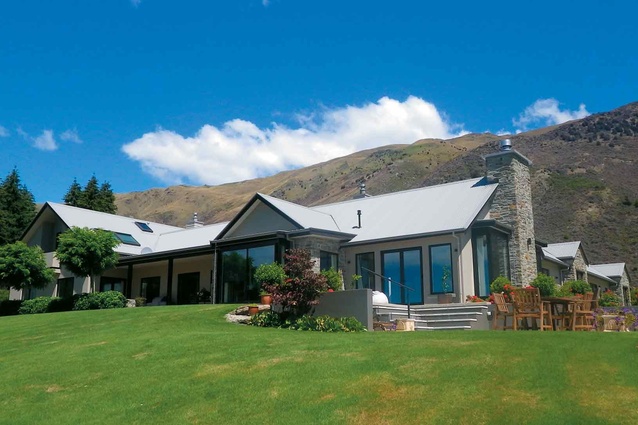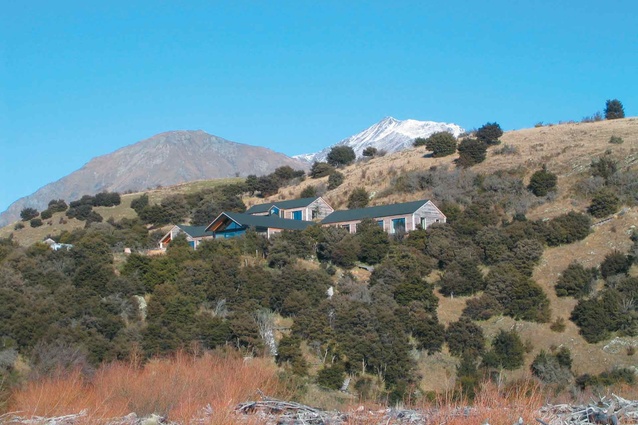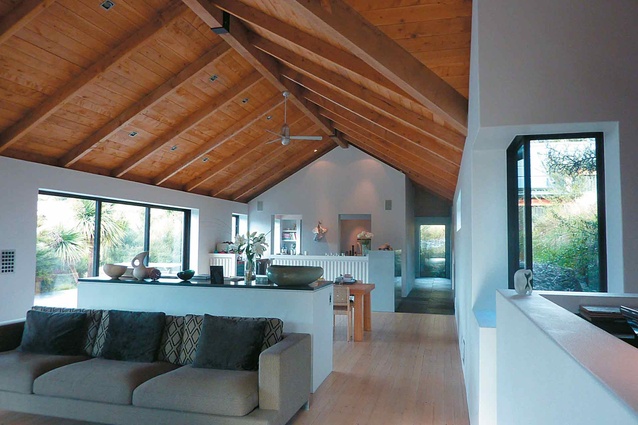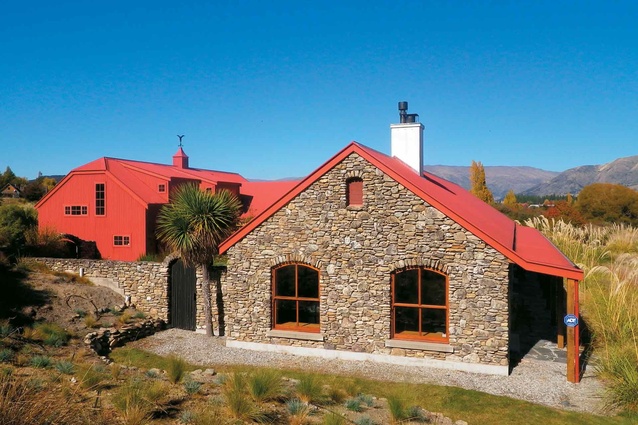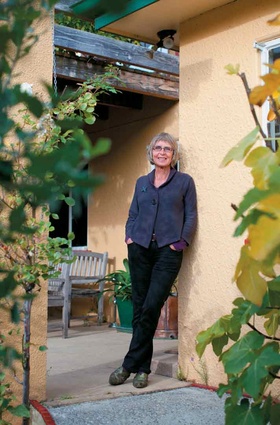Architect Sarah Scott in profile
Where did you grow up Sarah?
I was born in the Hawkes Bay, in Napier. I grew up mostly in Auckland and Wellington. We moved to Auckland when I was four and then moved to Wellington when I was 11. I went back to Auckland to go to Architecture School because in those days there was only one, the Auckland school. So I didn’t have any choice where I went for my degree.
Was it nice to go back to Auckland?
I went back and I enjoyed living there but I was 10 or 11 when we left and we lived at Papatoetoe, so it wasn’t like going home or anything.
When did you attend Auckland University?
1972 to 1975. I graduated in 1976.
Did you know that you wanted to study architecture from an early age?
No, but my parents’ first house was an architecturally designed house, as was their second house when I was 11. So I’d been exposed to it. I got to the end of sixth form and was taking all the wrong courses. I will be 60 this year and in those days the options for a woman wanting to do a profession were law and medicine or teaching really. I finally decided at the end of my sixth form year that I really did want to be an architect and I had to completely change all my courses. I scraped into Auckland and never looked back really.
Was it a competitive course?
It was pretty difficult then and the course has a big attrition rate as well, or it certainly did in those days. I think only forty five per cent that started the course actually completed it. In those days it was a five year Bachelor’s degree. It has now changed so that if you drop out after the first three years or don’t complete the full five years at least you have a Bachelor of Building Science.
Do you recall who designed your parents’ houses?
Yes, absolutely. The first house was by Guy Natusch who is the son of a very well known New Zealand colonial architect. Then the second house was designed by McKeefry and Brenton and that was in Wellington. The Auckland house that we lived in they bought, but it was designed by The Group Architects so I guess I was exposed to architecture in the houses that I grew up in.
So the first two houses you lived in were designed for your parents?
Yes, and the one they bought in Auckland was also an architecturally designed house, which was quite unusual in those days.
Can you remember your parents working with the architects?
I was around when the house was built, but I don’t have any recollection really of the process of working with the architects. I remember the architect though - he got drunk with my parents. I definitely remember them both - John McKeefry and Ben Brenton, not bad after 40 years is it? The earlier architect was a close family friend as well so I knew him even though I was not around when all that happened. I was four when we left the Napier house.
What kind of residential architecture market was there in New Zealand at the time?
When I started the developer was king, Queen Street was coming down thick and fast. There was renovation work all over Auckland. By the time I graduated in 1976 there was nothing, it was a mini recession so I think only about four or five graduates managed to get jobs in architectural offices. It went from buoyant to pretty depressed over that period of five years that I was doing my degree.
Could you see that happening?
It must have been up for discussion during the course of your studies? It was clear as we got into our last year and the ones that did get jobs were either the exceptional or top students which I was not. I went through with quite a few who had parents or fathers that were in the architectural occupation.
And so you didn’t have parents in the architecture profession I assume?
No.
What did you do after you graduated?
I went to work for a really interesting guy who was a craftsman and a builder. He brought in the first shingle cutting machine into New Zealand while I was working for him so I worked part time as a shingle roofer. He did a lot of work on the historic houses, Pompallier House and the Kemp House. I worked on St Andrew’s in Epsom at 45 degrees and did drafting work for him. So that was my first 18 months or so out of varsity.
What did you do after that?
My partner and I moved to Wellington and for the first 12 months or so I worked in the newly created Wellington office of what was then Jasmad (not Jasmax) on a project that they set up the office for initially. That project never went ahead and they closed the office and at that point I started working from home and taking on work just myself and effectively I’ve been in private practice ever since.
So it was a question of necessity?
When we got to Wellington I did the rounds, there wasn’t a single job. Again I was working for Jasmad for a year or just under a year and then at the end of the year the job disappeared. I absolutely did the rounds and there was nothing. I had no option but to start just taking on small projects.
How did you drum up work?
My partner at the time worked for an advertising agency and so I had this huge acquaintanceship in the advertising industry and then as we got into the early 1980s we were sort of getting to the glorious heyday of lots of people, well not lots of people, but people making money in that whole advertising/film industry during those years. So I basically ended up doing an awful lot of, in fact only, domestic renovation work. That was the thing that was happening in Wellington at the time plus a lot of restaurant and office fit outs and things. But no new houses, no houses from scratch.
Were you working on your own at that stage?
I was running my own practice but for about four years I shared an office with Roger Walker who’s a very dear friend of mine. We just literally worked side by side but ran two completely different businesses out of the same office. They were brilliant years but again it was all renovation work. Roger was doing endless new houses and masses of giant supermarkets and things and I was just doing small projects but it was a pretty amazing place to be.
Did you enjoy doing renovation work?
We still do a lot of it. I know a lot of architects find it painful but yeah I’ve always found it satisfying actually.
So this takes us through to the mid 1980s at that stage?
Yes. I practiced in Wellington basically for a few years and at that point I was single and unattached and I’d got to the stage where I just was really frustrated by the fact that I was only doing renovation work. I really wanted to have a go at some houses from scratch and for personal reasons I decided, much to the horror of my friends, to completely move myself to Wanaka. That’s where I’ve been for the last 24 years.
So you liked it then when you got there?
I’d travelled to Central Otago through my teens, fallen in love with Central Otago and I just felt that I needed a new direction and I’d always promised myself that one day I would live down here and thought now is the time.
Were your parents from the area?
No, but when we were teenagers we used to come down and stay with family friends and go skiing in Wanaka and in Queenstown and that was sort of our first introduction to Central Otago. We all just fell in love with Central Otago, and of my siblings, two of us live in Wanaka now. Another one in the South Island.
And so you were the first to go of your siblings?
I was the first yes. I came and that was it, I wasn’t planning to leave again. In those days it was interesting because I could have possibly chosen Queenstown but for various reasons Wanaka was my preference. In those days there were already probably eight to 10 architects practising in Queenstown but no-one here and for the first 10 years I was the only resident architect in the town. Wanaka over the 20 plus years I’ve lived here has just gone through an incredible transformation and it’s certainly been one of the more rapidly growing districts in the country over the last 10 or 12 years. All those friends that thought I was crazy to just walk out on a perfectly good practice in Wellington changed their mind very quickly.
Did you have something of a monopoly when you first arrived?
I guess but most people in this town had never seen or spoken to an architect in their life. So there was some novelty value and in those days I knew all the tradesmen. There were 1500 people in the town, not counting the floating population that comes in and out over the various holiday seasons.
It was really interesting in those early days working with the various contractors and tradesmen that I worked with because a lot of them had never actually worked with an architect before or ever seen architectural drawings. It was great. Twenty-four years on I still work with some of those same builders and still have really close relationships with them.
Did you transfer your practice with you from Wellington?
I kept going back and forth to Wellington in the first 18 months. I did nine trips in the first year, driving. Along the way I acquired a baby and two dogs. When you decide to change your life, suddenly everything changes. I didn’t acquire a husband but I did acquire a baby and two dogs. I just kept winding down the Wellington staff, taking on no more new work up there and building up a practice here and all the sort of stuff that you do.
Where did you live when you moved to Wanaka?
I sold my house in Wellington and bought a house here. I still live in the same house and still work in the house, well not in the house, in the garage attached to the house.
What are the best things are about running an architecture practice?
Well I guess the best thing for me would be my staff. There are four of us and as I say we all work in a small garage, 3.5 metres wide by 9 metres long. Lesley my wonderful office manger was a client. I did a beautiful lodge for her and her husband 11 years ago and she has been working for me ever since. My new partner Barry Condon has been with me seven and a half years and Jen who did an architectural degree in Scotland has been here four years next month. Dillon our fantastic draftee has been here a year. It’s a pretty amazing team of people who have collectively been together a long time and because we work in such close quarters we all work really closely and really well together.
Are there things that you find difficult about running an architecture practice?
I work at my place of residence and largely that is not an issue, but I have also raised two children. I’ve still got a 16 year old and the biggest thing for me is more a personal thing, with constant conflict of working full time and trying to juggle all that. For six years I was also in partnership with my brother. He had a restaurant so I was doing a lot of juggling. I gave up the restaurant some years ago although the restaurant is still running 18 years on. It’s called the White House, a beautiful old white art deco building built in the 1930s.
Do you design a lot of new houses now?
Yes we do a range of permanent residences and holiday homes. We also do a bit of work for overseas clients, people that have holiday homes here plus quite a bit of small commercial and large commercial. We’ve just done a beautiful Catholic church here in Wanaka which we won an NZIA Southern Region architecture award for. It is a really good mixture of work. We still do quite a bit of renovation work. Jen and I have got five renovation projects on at the moment, so it is a mix of small clients and large clients.
You obviously juggle a large number of projects at any one time?
I currently have 15 projects on our books and Barry Condon, who is my new partner, is fantastic so he takes quite a bit of the load off my shoulders on some of the bigger projects. Generally I run all the small projects but between us we seem to manage.
Do you find there are similarities between what your clients want in a new house?
Yes. With building down here efficiency is something that most of our clients focus on. The other big thing here is that clients are looking for low maintenance. It’s a very harsh climate and robustness of the materials is another thing that is definitely a focus. For the new houses and particularly for the people that live out of town probably the other great focus is the views of the mountains and the lake. The main views tend to be predominantly also in the face of the prevailing nor-wester, so that’s challenging as well. There’s a whole balance there too. Sometimes I have to remind my clients that those views are all out there and mostly in this town they’re out there in 360 degree direction and really you just need to step outside your door and walk a few paces. Sometimes I try and discourage excessive use of glazing, again because of the climate down here, for both summer and winter reasons. So there’s always a balance.
You must be familiar with the design issues that are particular to your area?
Yes pretty much. I’ve been incredibly fortunate over the years. I have projects located in some of the most stunning parts of the district, a lot of rural locations and some pretty exceptional landscapes, so it’s been a pretty amazing palette to be working in.
Have your clients’ expectations about how they’ll live in a house or what they want from a house changed since you started working in Wanaka?
Fashions have definitely changed. The sort of houses that we’re seeing built down here now are substantially different from what was being built here 25 years ago which I’m sure is an obvious thing to state.
People are influenced by what they see I suppose?
You look at all the amazing magazines and stuff that people have got access to these days, people have all sorts of expectations and all sorts of wonderful things that they’d like to achieve. Sometimes it’s a question of matching budgets, well always it’s a question of matching that with expectations and vice versa.
Do you think that sometimes having too much inspiration is a bad thing?
It can be. Not many of my clients are particularly guilty of that but I have seen it happen. There’s an overwhelming amount of product available too, particularly when you get into the realm, for example, of bathrooms. Twenty-five years ago it was Methven or Greens and now it’s any fitting that you want from anywhere in the whole world. From tiles, from kitchen appliances to floor coverings, there is an incredible amount of choice now that just wasn’t available 20 years ago and I think that often does make it hard for people.
Do you think there are interesting things happening in New Zealand residential architecture?
Oh yes. I think this country has got some amazing architects doing some really superb work and there are all sorts of incredible things happening.
Do you have a favourite New Zealand house?
There isn’t one that is absolutely screaming at me in terms of this is my most favourite house … I’ll tell you one that I do love though and that belongs to a really good friend of mine and was designed by McCoy and Wixon. It’s a little sweetheart and I’ve always loved that house. It is in Albertown on the river, beautiful board and batten and glass. It is a gorgeous little house. Just beautiful.


